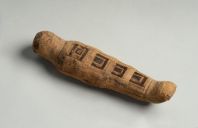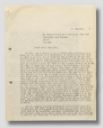Each thinks his owl is a falcon
Apart from an extensive library, NINO owns a unique collection of ancient Near Eastern artifacts. This Egyptian mummy is part of that collection. The fact that the NINO was very fond of collecting is also proven by its archive: it’s chock-full of boxes, folders, crates and discarded equipment. This might have something to do with the fact that there were quite a few archaeologists active at the NINO at the time, but in any event, a lot of things were stored here... Ranging from pre-war bus tickets to extensive correspondence, and from personal observations to financial administration. As such, it provides us with the opportunity to paint a truthful and complete picture of the NINO during the Second World War.
Here on the windowsill, you see a mummy of over 2,000 years old. It’s a mummified Egyptian falcon (or so we thought). About ten years ago, it was X-rayed, and funnily enough, it turned out that the mummy wrappings didn’t contain the remains of a falcon, but that of an owl. Still, it feels quite odd and unreal to think about the fact that a bird that was soaring over Egypt thousands and thousands of years ago, somehow ended up here in Leiden. It illustrates beautifully the bizarre turns history can take, and how our views of what is ‘right’ are always changing: taking antiquities to another country was seen as completely normal during the start of the previous century, while today, it’s mostly forbidden by law.
This mummy is part of our De Liagre Böhl Collection: a collection of antiquities collected by Frans de Liagre Böhl during his travels through the Middle East. The most important part of this collection are the 3,000 Mesopotamian clay tablets.
I’m Willemijn Waal and I’m the director at NINO: the Netherlands Institute for the Near East, founded in 1939 in Leiden.
The most important objective of the NINO is to promote and stimulate historical research into the area that now comprises present-day Iran, Iraq, Turkey, Syria, Lebanon and Egypt. We are at the service of all students and scholars who want to study the ancient languages of the region, or want to conduct archaeological research in the area. The NINO’s library, now part of the Leiden University Library, is one of the world’s largest in its field.
Sebastiaan: And NINO’s office is located in this corner of the building…
And there’s also an archive about the NINO itself…
Sebastiaan: And then here we have what is actually the most important part of the archive.
The voice you hear belongs to Sebastiaan Berntsen, archivist at the NINO. He has been of enormous help to me lately during the disclosure of the archive.
Sebastiaan: Some of the cabinets still have old suitcases filled with papers and forms, but there are also old boxes full of slides. Cigar boxes, here. Old pictures, but this right here, for example, is what they call an Abklatsch: a kind of papier mâché that you smear over an inscription. It hardens, and then it turns into a print of the inscription. Here, if you look closely, you see a female figure with hieroglyphs on each side. It is all a bit of a treasure trove, so to speak.
When I first started out as director, I began to browse this archive to get a better picture of the NINO’s history. Interestingly, the NINO never shut down during the war, as opposed to Leiden University, that did close its doors in 1942.
Sebastiaan: And well, there you see a big steel cabinet with all kinds of binders. And well, yes, they have the whole war archive hidden inside of them, from letters to bills, to little notes, to grocery lists, to university papers: it’s all in here.
Leafing through all these documents, I was struck by the way the impact of war shines through on all fronts, both the small, practical inconveniences, and the larger, human tragedies.
Take, for instance, this letter that we found, from right after the war ended, written by Arie Kampman, the NINO’s conservator at the time. With a great sense for drama, he writes about the hardships his employees had to endure:
The people got more and more hungry, but they persevered. […] They wrote articles in old rooms with tingling fingers; their teeth clenched, to be ready for the moment the enemy would be defeated. Professors teaching our courses had to go into hiding, they lost libraries, they fed themselves on tulips and sugar beet pulp.[…] In that last winter, my staff worked in temperatures of 4 degrees Celsius, but the work continued.
Kampman also tells us about the German raids of the institute. Twice they were surprised by the Wehrmacht:
After that first time, Böhl and I were summoned at the SS in The Hague because we had been “frech” enough to give stage to a Jew […] The second time, they discovered illegal literature at the Institute, they searched the stencil machine, found nothing, but the ‘gentlemen’ took Caspar Kern, our archeology assistant anyway, and he was held at the Oranjehotel in Scheveningen from April to August 1943.
But we also come across other, less spectacular things in the archive. Like an order for toilet paper. Companies and organizations had to order scarce products, such as paper, from so-called ‘Royal Bureaus’. There was a special Royal Bureau for paper, the paper processing and graphic industry, that allowed people to order toilet paper for their employees. To do that, you had to state the exact number of people employed, to prevent the delivery of too many rolls.
Sebastiaan: And yes, they also kept those kinds of requests and permits. And printer’s bills, too, and, you know, occasionally, a window broke, in 1943 for instance, and it had to be repaired, and all those kinds of things that illustrate daily life at the institute at the time.
But the archive also contains poignant letters in which a loved one informs of the passing or the deportation of a family member.
Sebastiaan: Yes, even in the archive of an academic institute like the NINO, the war suddenly gets very close.
Because of the war, the NINO’s employees were faced with many challenges. Not just on a practical and physical level, but on an ethical level as well. Because: did you stand up against the oppressor by resigning from your position? Or did you consider the continuation of academic research more important? In short: to what extent could you, as an institute, close yourself off from what went on outside of its walls?



